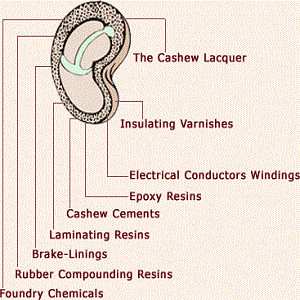
Cashewnut shell liquid is a by-product of the cashew industry. The nut has a shell of about 1/8 inch thickness inside which is a soft honeycomb structure containing a dark reddish brown viscous liquid. It is called the cashewnut shell liquid, which is the pericarp fluid of the cashewnut.
In the search for the cost effective modern materials, CNSL and its products have a significant role to play. Being renewable, it offers much advantage over synthetics. Its versatility stems from its innumerable applications in many areas. Recent research has shown that the constituents of CNSL possess special structural features for transformation into speciality chemicals and high value polymers. This involves a value addition of many orders of magnitude and the chemical transformation provides 100% chemically pure products. Thus, CNSL offers vast scope and opportunities for the production of speciality chemicals, high value products and polymers.

Advantages of CNSL based Polymers :
- Improved Flexibility and reduced brittleness.
- Solubility in Organic Solvents.
- Improved Processability.
- Low Fade Characteristics for Friction.
- Resistance to 'Cold Wear'.
- Good Electrical Resistance.
- Better Water Repellence.
- Improved alkali and acid resistance.
- Compatibility with other polymers.
- Antimicrobial Property.
- Termite and Insect Resistance.
- Structural Features for Transformation into High Performance Polymers.
Polymerisation Characteristics of CNSL
CNSL can be polymerised by a variety of methods:
- Addition Polymerisation through the side chain double bonds using
cationic initiators such as sulphuric acid, diethylsulphate etc.
- Condensation Polymerisation through the phenolic ring with aldehydic
compounds.
- Polymerisation after Chemical Modification to introduce speciality
properties.
- Oxidative Polymerisation.
- Various Combinations of the above.
Industrial Significance of CNSL
- Low Cost Phenol.
- Versatility in Polymerisation and Chemical Modification.
- Possibilities for Development of High Performance Polymers.
- Property advantage over phenolics in certain applications such as
impact resistance, flexibility, faster heat dissipation etc.
Reactivity :
CNSL undergoes all the conventional reactions of phenols. Cardanol differs from phenol only in the C15 side chain. It undergoes the well known formaldehyde condensation reaction of phenols that gives rise to phenolic polymers. Moreover, it can be polymerised through the unsaturation in the side chain although the bulky nature of the side chain restricts the molecular weight attainable to oligomers. One of the significant advantage of the cardanol is its amenability to chemical modification to effect desirable structural changes so as to get specific properties for making tailor-made polymers of high value. Thus, structural changes could be effected at the hydroxyl group, on the aromatic ring and on the side chain.
Cardanol
Distillation of CNSLunder reduced pressure gives cardanol. The residue will be rich in cardanol and is generally known as residol, which is conveniently used in the preparation of friction dust for brake linings, and also in rubber compounding formulations.
Specification for Treated Cashewnut Shell Liquid
The cashewnut shell liquid as extracted has a strong vesicant dermatatic action. Before this liquid is utilized for preparation of resins, it requires treatment to get rid of metallic impurities as well as traces of sulphur compounds. The liquid thus treated is known as " Treated Cashewnut Shell Liquid ".
The specification of treated cashewnut shell liquid is as follows:

PACKING CASHEW NUT SHELL LIQUID (CNSL)
Cashew Nut Shell Liquid can be packed in any of the following:
- MS drums – 200kgs net weight
- IBC Tanks
- Flexi tanks of ( 19KL/22KL/24KL)
- Tanker trucks